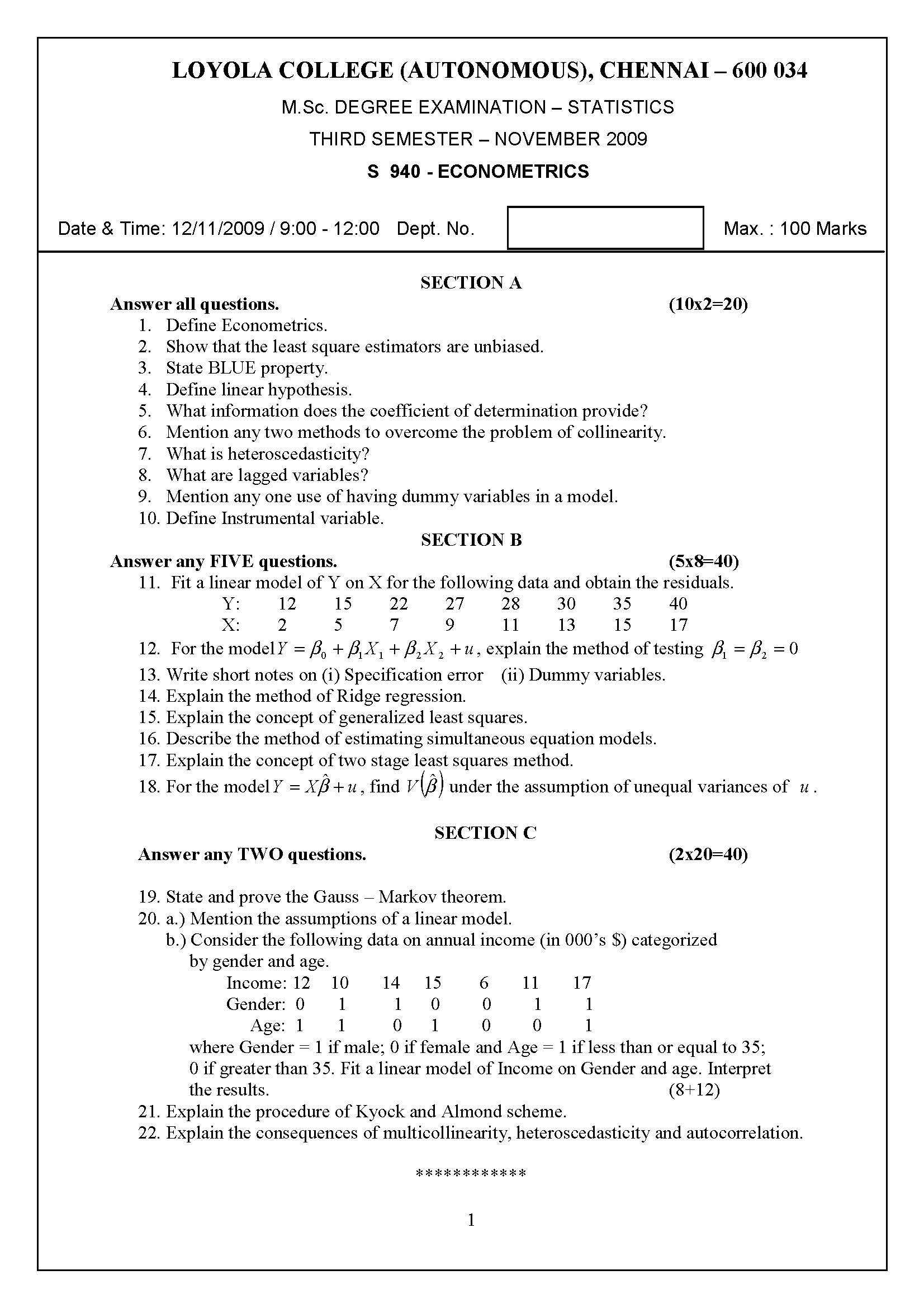LOYOLA COLLEGE (AUTONOMOUS), CHENNAI – 600 034
M.Sc. DEGREE EXAMINATION – STATISTICS
SECOND SEMESTER – APRIL 2007
ST 2950/3950 – ECONOMETRICS
Date & Time: 28/04/2007 / 1:00 – 4:00 Dept. No. Max. : 100 Marks
Section A
Answer all questions. (10*2=20)
- What is the difference between a linear and non-linear model?
- Give any two reasons for the inclusion of the ‘disturbance term’ in an econometric model.
- Interpret the following statement:
Pr{-0.25 < β2 < 1.3} = 0.95.
- Show that in a simple linear model the mean of the observed and estimated Y values are equal.
- What is ‘cross – section ‘data? Give an example.
- What is meant by ‘linear hypothesis’?
- “In a linear model involving dummy variable, if there are ‘m’ categories for the dummy variable, use only ‘m-1’ independent variables”. Justify the above statement.
- Define the term ‘autocorrelation’.
- For a four variable regression model, the observed and estimated (under OLS) values of Y are given below:
Observed Y: 10 14 13 12 17
Estimated Y: 10 13 11 14 15
Calculate the standard error of the estimate.
- Mention any two consequences of multicollinearity.
Section B
Answer any five questions. (5*8=40)
- Mention the assumptions in the classical linear regression model.
- Suppose that a researcher is studying the relationship between gallons of milk consumed by a family per month (Y) and the price of milk each month (X in dollars per gallon). The sample consists of observations in 12 consecutive months. Analysis of the data reveals the following:
SY = 480; SX=36; Sxy=-440
Sx2 = 20; = 528, where x and y are deviates of X and Y from their respective means.
For this sample, find the following:
- Least squares intercept and slope
- Standard error of regression.
- Standard error of the slope.
- Test the hypothesis that the slope coefficient is zero at 5% level.
- Calculate TSS, ESS, RSS and R2 for the following data assuming a linear model of Y on X.
Y: 12 10 14 13 16 14
X: 2 4 7 10 12 13
- Explain the concept of structural change with an example.
- What is meant by interval estimation? Derive a 100(1-α) % confidence interval for the slope parameter in a simple linear model.
- Explain the various methods of detecting multicollinearity.
- Consider the following OLS regression results with standard errors in
parenthesis:
S = 12,000 – 3000X1 + 8000(X1 + X2)
(1000) (3000) n = 25
where S = annual salary of economists with B.A. or higher degree
X1 = 1 if M.A. is highest degree; 0 otherwise
X2 = 1 if Ph.D is highest degree; 0 otherwise
- What is S for economists with a M.A. degree?
- What is S for economists with a Ph.D degree?
- What is the difference in S between M.A.’s and Ph.D’s?
- At 5% level of significance, would you conclude that Ph.D’s earn more per year than M.A.’s?
- Explain the method of estimating the regression parameters in the presence of heteroscedasticity.
Section C
Answer any two questions. (2*20=40)
- a.) State and prove Gauss – Markov theorem.
b.) Show that for a ‘k’ variable regression model, the estimator
= (e1e)/(n-k) is unbiased for σ2. (12+8).
- a.) Derive a test procedure for testing the linear hypothesis Rβ = r where R
is a known matrix of order q x k with q ≤ k and r is a known q x 1
vector.
b.) Explain the procedure for testing the equality of the slope coefficients of
two simple linear models using dummy variables. (10+10)
- a.) Consider the following data on weekly income(Y), gender and status.
Y: 110 100 120 115 145 136 102 150
Gender: 1 1 0 1 0 0 1 0
Status: 0 0 1 1 1 0 1 0
where gender = 1 if male; 0 if female
Status = 1 if minor; 0 if major.
Assuming a linear model of Y on gender and status, estimate the
regression coefficients. Interpret the results.
b.) Define the following:
1.) Standard error of the estimate
2.) Ordinal data
3.) Variance Inflating Factor
4.) Coefficient of Determination. (10+10)
- a.) For the following data, use Spearman’s rank correlation test to for the
presence of heteroscedasticity.
Y: 10 14 20 25 13 19 10 35
X: 1.3 2.1 2.5 3.0 1.7 1.9 1.0 2.9
b.) Explain the Breusch – Pagan – Godfrey test. (10+10).
Go To Main Page


